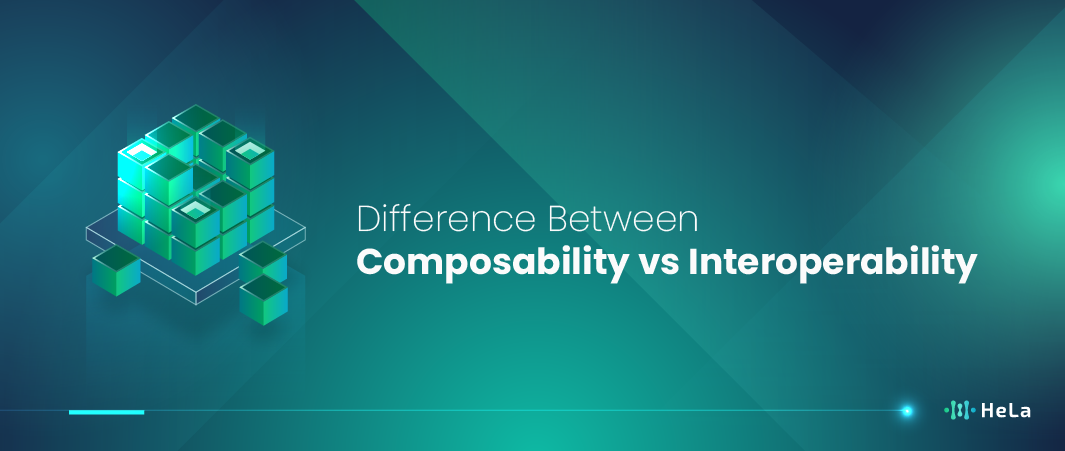In the rapidly evolving landscape of technology, the terms “composability” and “interoperability” frequently surface, often leading to confusion due to their interconnected yet distinct meanings. Understanding these concepts is crucial, as they play a significant role in the development and integration of modern software systems. Whether you’re a developer, business professional, or simply a tech enthusiast, grasping the core differences between composability and interoperability can provide valuable insights into how systems are designed, built, and maintained.
Composability refers to the ability to assemble various components in a system in a flexible manner, allowing them to work together seamlessly. This concept emphasizes modularity, reusability, and the ease of integration, which can lead to more efficient and scalable software solutions. On the other hand, interoperability focuses on the capacity of different systems or software applications to communicate, exchange data, and use the information that has been exchanged effectively. This concept ensures that systems can work together, even if they are developed by different organizations or in different technological environments.
In this article, we will delve deeper into the definitions of composability and interoperability, explore their key differences, provide real-world examples, and discuss the challenges and considerations associated with each. By the end, you’ll have a comprehensive understanding of how these concepts influence technology today.
What is Composability?

Composability is the design principle that allows various components of a system to be selected and assembled in various combinations to satisfy specific user requirements. This concept is grounded in the idea of modularity, where different parts of a system can function independently yet work together cohesively when combined. The main goal of composability is to create flexible, reusable, and adaptable systems.
In software development, composability often manifests through microservices and modular design patterns. Each module or microservice serves a specific function and can be developed, tested, and deployed independently. When these modules are composed, they form a complete system that can be easily modified or scaled by adding, removing, or updating individual components without affecting the whole system.
Also Read: 12 Crypto Ambassador Programs to Join in 2024
A real-world example of composability can be seen in modern web development. Consider a web application where the user authentication system, payment processing system, and content management system are all separate modules. Each module can be developed independently and then composed together to form a fully functional application. This allows developers to update the authentication system without disrupting the payment processing or content management functionalities.
Composability is particularly beneficial in environments that demand rapid changes and scalability. By leveraging composable components, organizations can quickly respond to changing market needs, incorporate new technologies, and improve overall system resilience. Moreover, it promotes code reuse, reducing redundancy and enhancing the maintainability of the software.
What is Interoperability?

Interoperability is the ability of different systems, applications, or components to communicate, exchange data, and use that information effectively. Unlike composability, which focuses on the internal modularity of a single system, interoperability emphasizes the seamless interaction between disparate systems, often built by different organizations or using different technologies.
The primary objective of interoperability is to ensure that various systems can work together to achieve a common goal. This is particularly crucial in industries where multiple systems need to collaborate, such as healthcare, finance, and government services. Interoperability allows these systems to share information without requiring significant changes to their underlying architecture.
A classic example of interoperability can be found in healthcare, where different electronic health record (EHR) systems need to exchange patient information. A patient’s medical history recorded in one hospital’s system should be accessible and usable by another hospital’s system, regardless of the software they use. This ability to share and use data across systems improves patient care, reduces errors, and enhances efficiency.
Interoperability is achieved through various standards and protocols that define how data should be formatted, transmitted, and interpreted. For instance, in the web world, standards like HTTP and RESTful APIs enable different web services to communicate with each other. Similarly, in the healthcare sector, standards like HL7 and FHIR ensure that different EHR systems can exchange data seamlessly.
The importance of interoperability extends beyond data exchange. It also encompasses the usability of the exchanged data, ensuring that the information received by one system can be processed and understood correctly. This aspect is vital for creating integrated solutions that provide a unified experience for end-users.
Key Differences Between Composability and Interoperability

While composability and interoperability are both crucial for building flexible and integrated systems, they serve different purposes and are achieved through different means. Understanding the core differences between these two concepts is essential for leveraging their strengths in system design and development.
Purpose
Composability:
- Focuses on the internal modularity of a single system.
- Aims to create systems that can be easily modified, extended, or scaled by reassembling components.
- Emphasizes the reuse of components within the same system or across similar systems.
Interoperability:
- Concentrates on the ability of different systems to work together.
- Aims to facilitate seamless communication and data exchange between disparate systems.
- Emphasizes the integration of systems built by different organizations or using different technologies.
Approach
Composability:
- Achieved through modular design, where each component is self-contained and can operate independently.
- Utilizes principles like microservices, plug-ins, and libraries to build systems.
- Focuses on the internal structure and how components within a system interact.
Interoperability:
- Achieved through the use of standardized protocols and data formats.
- Utilizes APIs, data exchange standards, and middleware to enable communication between systems.
- Focuses on external interactions and ensuring that different systems can interpret and use shared data.
Implementation
Composability:
- Often involves designing systems with interchangeable parts that can be recombined in various ways.
- Example: A web application built with modular components like user authentication, payment processing, and content management, which can be individually updated or replaced.
Interoperability:
- Involves ensuring that systems adhere to common standards and protocols for data exchange.
- Example: Different electronic health record systems in healthcare that can share patient information using standards like HL7 or FHIR.
Benefits
Composability:
- Increases flexibility and adaptability of systems.
- Enhances scalability by allowing individual components to be updated or replaced without affecting the entire system.
- Promotes code reuse and reduces redundancy.
Interoperability:
- Enables diverse systems to work together, facilitating broader integration and collaboration.
- Improves efficiency by allowing data to be shared and used across systems without manual intervention.
- Enhances user experience by providing a seamless flow of information between systems.
Understanding these differences helps in choosing the right approach based on the specific needs of a project. Both composability and interoperability are valuable, but their applications and benefits vary depending on the context.
Examples of Composability and Interoperability in Action
To better understand the practical applications of composability and interoperability, let’s explore some real-world examples where these concepts play a crucial role in system design and functionality.
Composability in Action
Microservices Architecture
One of the most prominent examples of composability is the microservices architecture. In this approach, an application is built as a collection of loosely coupled services, each responsible for a specific function. For instance, an e-commerce platform might have separate microservices for user authentication, product catalog, order processing, and payment handling. Each microservice can be developed, deployed, and scaled independently, allowing the entire application to be flexible and adaptable to changing requirements.
Software Development Kits (SDKs)
SDKs are another example of composability. Developers can use various SDKs to add specific functionalities to their applications without building everything from scratch. For instance, a mobile app developer might use an SDK for integrating social media login, another for payment processing, and yet another for analytics. These SDKs are modular components that can be composed to create a fully functional application.
Interoperability in Action
Healthcare Systems
In the healthcare industry, interoperability is critical for ensuring that patient information can be shared across different healthcare providers and systems. For example, a patient’s medical history recorded in a hospital’s electronic health record (EHR) system should be accessible to a specialist at another clinic. Standards like HL7 and FHIR facilitate this by defining how medical data should be structured and exchanged, ensuring that different EHR systems can interoperate seamlessly.
Financial Services
In the financial sector, interoperability enables banks, payment processors, and financial institutions to work together. For example, when you use your credit card to make a purchase, multiple systems from the merchant, payment gateway, card network, and issuing bank must communicate to authorize and process the transaction. Standards like ISO 20022 for financial messaging ensure that these systems can exchange information accurately and efficiently.
Smart Home Ecosystems
Interoperability is also vital in smart home ecosystems, where devices from different manufacturers need to work together. For example, a smart thermostat, lighting system, and security camera from different brands must communicate to create an integrated home automation system. Protocols like Zigbee, Z-Wave, and more recently, the Matter standard, enable this interoperability, allowing users to control all their devices from a single platform.
Combining Composability and Interoperability
In many cases, systems benefit from both composability and interoperability. For example, a cloud computing platform like Amazon Web Services (AWS) offers a composable infrastructure where users can choose from a variety of services like compute, storage, and databases. These services are designed to be composable, allowing users to build and scale their applications. At the same time, AWS ensures interoperability with other systems and services through APIs and support for various data exchange standards, enabling seamless integration with external systems.
By leveraging both composability and interoperability, organizations can build robust, flexible, and integrated systems that meet diverse and evolving needs.
Challenges and Considerations
While composability and interoperability offer significant benefits, they also come with their own set of challenges and considerations. Understanding these can help in making informed decisions during system design and implementation.
Challenges of Composability
Complexity in Design
Creating a composable system requires careful planning and design. Ensuring that individual components can work independently and together seamlessly demands a deep understanding of the system’s requirements and potential interactions between components.
Dependency Management
As systems grow, managing dependencies between different components can become complex. Changes in one component may require updates in others to maintain compatibility, which can lead to potential integration issues.
Performance Overheads
In some cases, the modular nature of composable systems can introduce performance overheads. Each component may need to communicate with others through defined interfaces, which can be less efficient than internal calls within a monolithic system.
Security Concerns
With multiple independent components, ensuring consistent security practices across all parts of the system can be challenging. Each component needs to be secure in itself and in its interactions with other components
Challenges of Interoperability
Standardization Issues
Achieving interoperability often relies on adhering to standards and protocols. However, the lack of universally accepted standards in some domains can hinder interoperability efforts. Even when standards exist, different interpretations and implementations can lead to incompatibilities.
Data Mapping and Transformation
Different systems may use varying data formats and structures, necessitating data mapping and transformation to enable meaningful data exchange. This process can be complex and error-prone, requiring robust solutions to ensure data integrity.
Legacy Systems
Integrating modern systems with legacy systems that were not designed with interoperability in mind can be particularly challenging. Legacy systems may use outdated technologies and proprietary formats, making it difficult to establish seamless communication.
Security and Privacy
When different systems exchange data, ensuring the security and privacy of that data is paramount. Interoperability can introduce vulnerabilities if data is not adequately protected during transmission and storage. Additionally, regulatory compliance regarding data privacy must be maintained.
Considerations for Implementation
Clear Definitions and Standards
Establishing clear definitions and standards is crucial for both composability and interoperability. Organizations should adopt widely accepted standards and best practices to ensure compatibility and ease of integration.
Also Read: What Is a Merkle Tree in Blockchain?
Robust Testing
Thorough testing is essential to identify and resolve issues in both composable and interoperable systems. This includes unit testing for individual components, integration testing for combined components, and end-to-end testing to ensure the entire system functions correctly.
Documentation and Communication
Comprehensive documentation and effective communication are vital for successful implementation. Detailed documentation helps developers understand how to use and integrate components, while clear communication ensures all stakeholders are aligned on goals and practices.
Scalability and Flexibility
Systems should be designed with scalability and flexibility in mind. This involves considering future growth and potential changes, ensuring that the system can adapt without significant overhauls.
By addressing these challenges and considerations, organizations can harness the power of composability and interoperability to build robust, flexible, and integrated systems that meet their needs.
Conclusion
In the ever-evolving technological landscape, understanding the nuances between composability and interoperability is essential for building effective, adaptable, and integrated systems. Composability focuses on the internal modularity of a system, allowing components to be independently developed, deployed, and reused. This approach promotes flexibility, scalability, and maintainability, making it easier to adapt to changing requirements and incorporate new features. By designing systems with composability in mind, organizations can enhance their ability to innovate and respond quickly to market demands.
Interoperability emphasizes the ability of different systems to communicate and work together. This is crucial for ensuring that disparate systems can share and utilize data effectively, regardless of their underlying technologies or origins. Interoperability is particularly important in sectors like healthcare, finance, and smart home technology, where seamless data exchange can lead to improved outcomes and user experiences. Both composability and interoperability come with their own set of challenges, such as managing dependencies and overcoming standardization issues, but these can be effectively addressed with clear definitions, robust testing, and comprehensive documentation.
Leveraging the strengths of both composability and interoperability can lead to the creation of robust, flexible, and integrated systems that are well-equipped to meet the demands of today’s dynamic technological environment. By understanding and applying these principles, organizations can build solutions that are not only efficient and scalable but also capable of evolving alongside technological advancements. Whether you are a developer, business professional, or tech enthusiast, a deep understanding of composability and interoperability will equip you with the knowledge to navigate and excel in the complex world of technology.
Disclaimer: The information provided by HeLa Labs in this article is intended for general informational purposes and does not reflect the company’s opinion. It is not intended as investment advice or recommendations. Readers are strongly advised to conduct their own thorough research and consult with a qualified financial advisor before making any financial decisions.

Joshua Soriano
I am a writer specializing in decentralized systems, digital assets, and Web3 innovation. I develop research-driven explainers, case studies, and thought leadership that connect blockchain infrastructure, smart contract design, and tokenization models to real-world outcomes.
My work focuses on translating complex technical concepts into clear, actionable narratives for builders, businesses, and investors, highlighting transparency, security, and operational efficiency. Each piece blends primary-source research, protocol documentation, and practitioner insights to surface what matters for adoption and risk reduction, helping teams make informed decisions with precise, accessible content.
- Joshua Soriano#molongui-disabled-link
- Joshua Soriano#molongui-disabled-link
- Joshua Soriano#molongui-disabled-link
- Joshua Soriano#molongui-disabled-link

